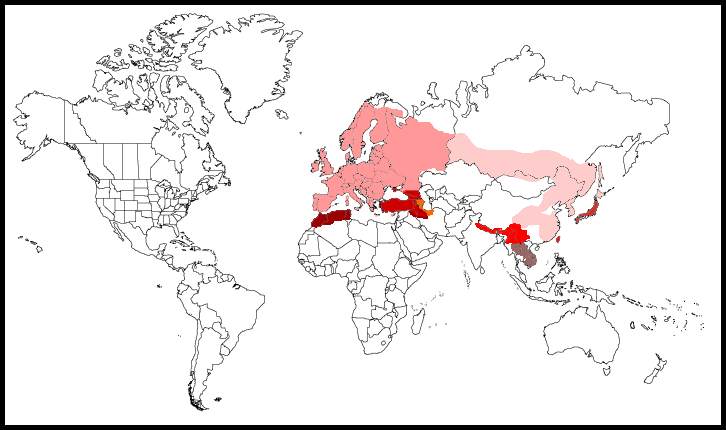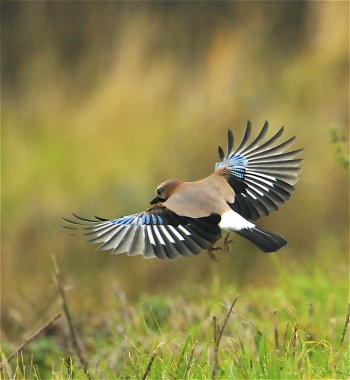(trying to internationalise the article.....) |
(map added) |
||
| Line 8: | Line 8: | ||
Crimean race ''iphigenia'', Turkish and Caucasian ''krynicki'', ''atricapillus'' from the Middle East and ''rhodius'' from [[Rhodes]] have black crowns and whitish faces (more rufous in krynicki). Race ''severzowii'' from Scandinavia to the Urals intergrades between nominate and more eastern forms with rufous head and nape and contrasting grey mantle. | Crimean race ''iphigenia'', Turkish and Caucasian ''krynicki'', ''atricapillus'' from the Middle East and ''rhodius'' from [[Rhodes]] have black crowns and whitish faces (more rufous in krynicki). Race ''severzowii'' from Scandinavia to the Urals intergrades between nominate and more eastern forms with rufous head and nape and contrasting grey mantle. | ||
==Distribution== | ==Distribution== | ||
| − | Occurs in most of [[Europe]], North [[Africa]], the [[Middle East]], [[Siberia]], [[China]], [[Japan]], the [[Himalayas]] and [[Indochina]].<br /> | + | {| cellpadding="5" |
| + | |- | ||
| + | | rowspan=2 valign="center"| | ||
| + | [[Image:Map-EurasianJay.png|left]] | ||
| + | |Occurs in most of [[Europe]], North [[Africa]], the [[Middle East]], [[Siberia]], [[China]], [[Japan]], the [[Himalayas]] and [[Indochina]].<br /> | ||
Mainly resident but occasionally irruptive in far north of range and can result in birds of northern subspecies occuring in winter. | Mainly resident but occasionally irruptive in far north of range and can result in birds of northern subspecies occuring in winter. | ||
| − | + | |- | |
| + | |<font size=4>Legend</font><br> | ||
| + | '''<font color="#FF9999" style="background-color: black">•</font>''' nominate group<br> | ||
| + | '''<font color="#990000" style="background-color: black">•</font>''' ''cervicalis'' group<br> | ||
| + | '''<font color="#CC0000" style="background-color: black">•</font>''' ''atricapillus'' group<br> | ||
| + | '''<font color="#FF6600" style="background-color: black">•</font>''' ''hyrcanus'' group<br> | ||
| + | '''<font color="#FFCCCC" style="background-color: black">•</font>''' ''brandtii'' group<br> | ||
| + | '''<font color="#CC3333" style="background-color: black">•</font>''' ''japonicus'' group<br> | ||
| + | '''<font color="#FF0000" style="background-color: black">•</font>''' ''bispecularis'' group<br> | ||
| + | '''<font color="#996666" style="background-color: black">•</font>''' ''leucotis'' group<br> | ||
| + | <font size="1">Maps/Texts consulted<sup>[[#References|3]]</sup></font> | ||
| + | |} | ||
[[Image:DSC5019.jpg|thumb|350px|right|Photo by {{user|angletarn|angletarn}}<br />[[Brandon Marsh]], [[Warwickshire]], November 2009]] | [[Image:DSC5019.jpg|thumb|350px|right|Photo by {{user|angletarn|angletarn}}<br />[[Brandon Marsh]], [[Warwickshire]], November 2009]] | ||
Revision as of 11:26, 14 May 2010
- Garrulus glandarius
Identification
Plumage mainly pinkish-brown. Whitish throat and vent. Black moustachial stripe. Blue, black and white panels on wings.
North African birds show a greyer mantle and contrasting rufous nape, cervicalis from northern parts of Algeria and Tunisia has black crown, whitish sides to head and grey tail-base. Moroccan Atlas race minor and north Morocco-west Algerian whitakeri has broad crown streaks and sides of head more rufous.

Photo by scottishdude
Lesvos, April 2010
Crimean race iphigenia, Turkish and Caucasian krynicki, atricapillus from the Middle East and rhodius from Rhodes have black crowns and whitish faces (more rufous in krynicki). Race severzowii from Scandinavia to the Urals intergrades between nominate and more eastern forms with rufous head and nape and contrasting grey mantle.
Distribution
| Occurs in most of Europe, North Africa, the Middle East, Siberia, China, Japan, the Himalayas and Indochina. Mainly resident but occasionally irruptive in far north of range and can result in birds of northern subspecies occuring in winter. | |
| Legend • nominate group |
Taxonomy
More than 30 subspecies of this bird have been described with about 20 from the Western Palearctic. These fall into several groups with the nominate group found over most of Europe.
Subspecies[1]
- Nominate group:
- G. g. rufitergum: Southern Scotland, England, Wales and northern France
- G. g. hibernicus: Ireland
- G. g. glandarius: Northern and central Europe
- G. g. severtzowi: Scandinavia and western Russia (sometimes merged into glandarius)
- G. g. lusitanicus: Northern Portugal and northern Spain (sometimes merged into fasciatus)
- G. g. fasciatus: Southern, central and eastern Spain
- G. g. corsicanus: Corsica
- G. g. albipectus: Italy, Dalmatian coast of Yugoslavia, Albania and Ionian Islands
- G. g. jordansi: Sicily (sometimes merged in albipectus)
- G. g. ichnusae: Sardinia
- G. g. graecus: Southern Yugoslavia, southern Bulgaria and Greece
- G. g. cretorum: Crete
- G. g. glaszneri: Cyprus
- G. g. fernandi: South-eastern Bulgaria to northern Turkey (Istranca Mountains)
- cervicalis group - Black-crowned Jay:
- atricapillus group - Black-capped Jay
- G. g. atricapillus: Lebanon to southern Syria, Israel and western Jordan
- G. g. anatoliae: Western Turkey and eastern Aegean Sea to western Asia Minor, northern Iraq and south-western Iran
- G. g. samios: Samos and Ikaria region of eastern Aegean Sea (Greece)
- G. g. iphigenia: Crimean Peninsula
- G. g. krynicki: Caucasus, Transcaucasia and northern Asia Minor
- hyrcanus group - Iranian Jay
- G. g. hyrcanus: Northern Iran (Elzburg Mountains and south shore of Caspian Sea)
- brandtii group - Brandt's Jay
- G. g. brandtii: Ural Mountains to Siberia, Lake Baikal and Altai and Sayan mountains
- G. g. bambergi: Mongolia to Sakhalin, southern Kuril Islands, Hokkaido and Korea (sometimes merged with brandtii)
- G. g. kansuensis: Kazakhstan (eastern Tien Shan) and western China (Gansu)
- G. g. pekingensis: Northern China (Liaoning) and south-western Manchuria
- japonicus group - Japanese Jay
- bispecularis group - Himalayan Jay or Red-crowned Jay
- G. g.s sinensis: Western China to northern Yunnan and north-eastern Myanmar
- G. g. taivanus: Taiwan
- G. g. persaturatus: Northern India (Khasi Hills of Assam) (sometimes merged with bispecularis)
- G. g. bispecularis: Himalayas (Kashmir to Nepal)
- G. g. interstinctus: Eastern Himalayas and south-eastern Tibet
- G. g. oatesi: Central Myanmar (upper Chindwin and Chin Hills)
- leucotis group - White-faced Jay
DNA reserach has shown only minor differences of small significance.
Habitat
Mainly deciduous woodland and forest, and oak in particular. Also in mixed forest, orchards, town parks and large gardens, and coniferous forest in the north and east of the Region.
Behaviour
Usually a very shy and wary bird, keeping in dense foliage. However, in city parks birds can become very confiding. Normally solitary or in family groups.
Diet
An omnivorous feeder. The diet includes invertebrates (notably caterpillars and beetles) but also eggs and nestlings and a wide variety of seeds and berries. Does visit garden birdtables where unmolested.
Breeding
Breeding starts in April in most of Europe. A pair stays together several years, possibly even lifelong. The nest is built by both sexes. It's a platfrom of twigs, placed some 4 to 6m above the ground, usually well concealed by foliage and near the tree centre. Lays 3 - 10 eggs (chiefly 5 - 7) which are incubated 16 - 17 days by the female. The nestling period is 19 - 23 days.
Vocalisation
The alarm call is a harsh, rasping screech. It is a great mimic.
<flashmp3>Garrulus glandarius (song).mp3</flashmp3>
Listen in an external program
References
- Clements, JF. 2009. The Clements Checklist of Birds of the World. 6th ed., with updates to December 2009. Ithaca: Cornell Univ. Press. ISBN 978-0801445019.
- BF Member observations
Recommended Citation
- BirdForum Opus contributors. (2024) Eurasian Jay. In: BirdForum, the forum for wild birds and birding. Retrieved 4 May 2024 from https://www.birdforum.net/opus/Eurasian_Jay
External Links






